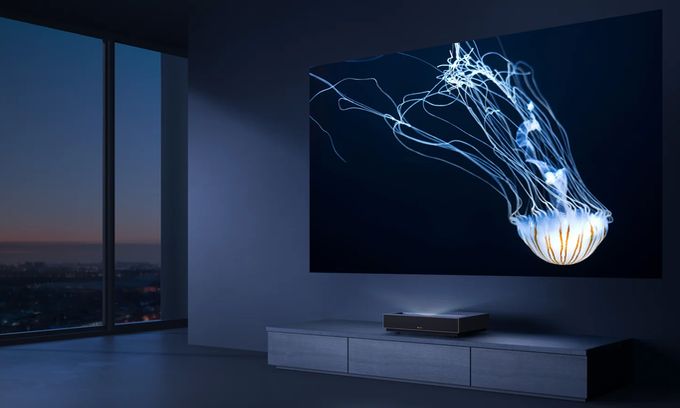A few years ago, Formovie brand was little known in America and Europe, but today its popularity is growing rapidly. As known, Formovie Tech was created as a joint venture between Xiaomi and Appotronics, and is part of the Mi ecosystem. The Chinese giant Xiaomi hardly needs any introduction. Approtronics is one of the leaders in the laser display technologies segment. In particular, it developed Advanced Laser Phosphor Display (ALPD) technology, which is the basis for solid-state (SSL) light engines.

Modern projectors actively use ALPD 3.0 (laser+phosphor), and more expensive ALPD 4.0 (triple-laser RGB design with ultra wide color gamut) version. Unfortunately, the interference of coherent laser beams sometimes creates speckles in the image. However, company has radically reduced this problem in Formovie Theater with the help of speckle elimination technology.
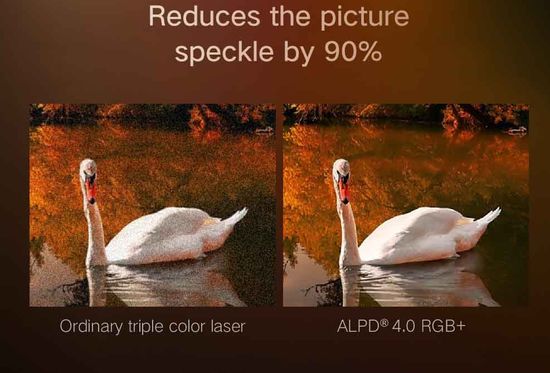
This 4K ultra-short throw (UST) model offers certified Android 11.0, sound by Bowers & Wilkins, delivers 2,800 ANSI Lumens brightness and covers 107% BT.2020 color space.
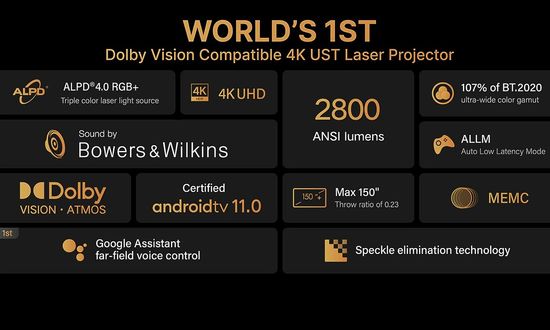
Moreover, speckle elimination technology radically minimizes this effect. Priced at ~ $ 2,800, projector offers superb value for money, features on many top lists and successfully competes with established competitors.
This year the company introduced ultra compact Xiaomi Fengmi Formovie P1 and compact mid-focal Formovie X5.
Of course, the popular UST projectors were not forgotten either. At the beginning of the year, the company introduced Formovie C2. Depending on the region, its launch price reached ~£ 2,700 / $ 2,700 / € 2,700 with 100-inch Fresnel screen. However, after the traditional correction, it dropped to ~$ 1,800 / € 1,600.
Moreover, in the fall the company announced the Formovie C3 with an unprecedentedly low launch price of ~£ 1,900 / $ 1,900 / € 1,800.
Projector screen
However, the projector price has its nuances. As known, ambient lighting makes the TV or projector image faded and dull. This problem is solved with the help of room darkening, or by increasing the brightness.
Unlike TVs, projectors use reflected light from the screen with large losses of luminous flux. Therefore, even premium projectors rarely provide the brightness more than several hundred nits. Companies partially solve this problem with the help of Ambient Light Rejecting (ALR) screens, which effectively re-reflect the light flow into the viewing area due to the complex surface structure.
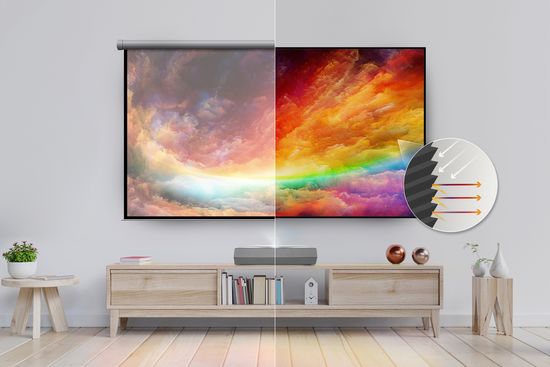
In fact, UST ALR screen improves image quality without increasing the power and price of the projector.
Not wanting to risk their reputation due to quality not meeting the stated level, some industry leaders began selling premium projectors only with a screen included. But they are very expensive and significantly increase the price of the projector. For example, the price of a Formovie Theater with a 120″ Spectra UST screen included reaches ~$ 5,000 vs $ 2,800 without a screen. But the consumer market without enthusiasm воспринял this practice. Indeed, the projector can be used in the evenings, with blackout curtains on the windows, or with a relatively cheap screen. Finally, the lucky owner can win an expensive UST screen in a lottery, receive it as a gift or as an inheritance.
As a result, almost all industry leaders today offer only optional screens. But of course, the choice of model should take into account the delivery set. Simply put, the $ 3,500 Formovie Theater is too expensive without a screen, but very cheap with the 120″ Spectra UST screen included. Prices in this article refer to projectors without a screen included.
Formovie C2 vs Formovie Theater vs C3
In fact, Formovie C2 became a cheaper version of the flagship Formovie Theater with more modest specs. Both models have:
– ALPD technology-based light engine;
– 4K UHD resolution – TI DLP .47″ chip with 4K XPR eShift technology;
– 3,000:1 native contrast (full on/off);
– up to 150″ image size with 0.23:1 throw ratio.
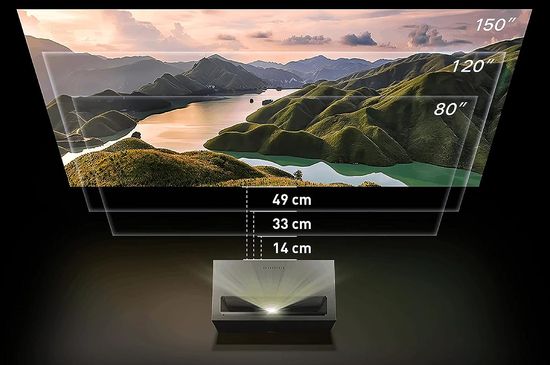
– Wi-Fi 6 + Bluetooth 5.0;
– audio- 2x 15W (Bowers & Wilkins in Formovie Theater);
– 8-point keystone correction.
They also support Motion Estimation and Motion Compensation (MEMC), ensuring smooth playback of fast-moving scenes.

The list of differences is quite wide and includes (Formovie C2 vs Formovie Theater:
– price ~ $ 1,800 vs $ 2,800;
– ALPD 3.0-based laser-phosphor light engine (covers 110% Rec.709 – color gamut) with 2,100 ANSI lumens brightness (up to 380 nit) vs ALPD 4.0-based RGB light engine (107% BT.2020) with 2,800 ANSI lumens brightness (up to 480 nit).
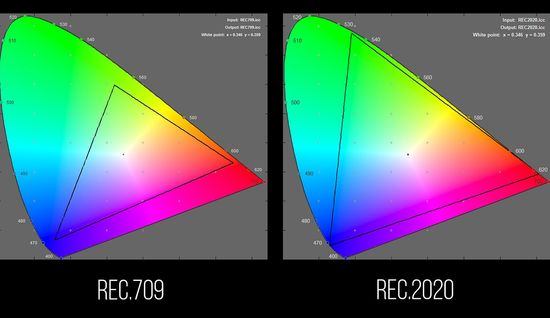
– HDR10 vs Dolby Vision, HDR10+;
– Android TV 9.0 (FengOS) vs Android TV 11.0;
– Dolby Audio, DTS-HD vs Dolby Atmos, Dolby Audio, DTS/X, DTS – HD.
Price, specs and functionality C2 vs C3 are almost identical. They use Android + FengOS, offer Auto Focus, AI Picture Enhance, Intelligent Obstacle Avoidance and Enhanced Gaming mode (up to 40ms input lag), support multiple interfaces, Cromecast, Google Assistant, etc. A short list of differences includes (C3 vs C2):
– brightness – 2,250 ANSI Lumen (~400 nit) vs 2,100 ANSI Lumen (~380 nit);
– CPU – new 4-core MT9669 vs Amlogic T972;
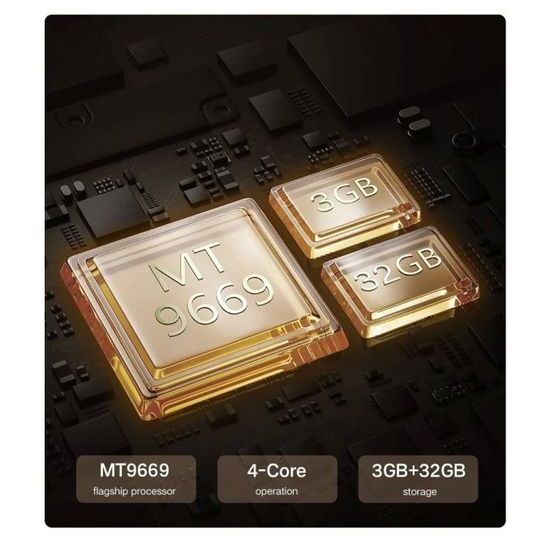
– memory (RAM+ROM) – 3GB+32GB vs 2GB+16GB;
– HDR 10+ vs HDR10;
– up to 200″ image.
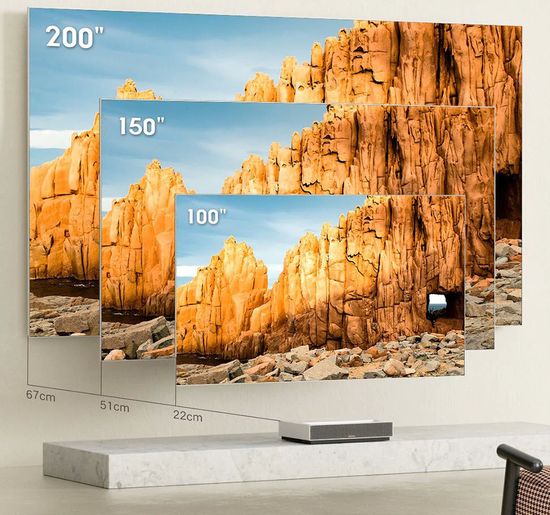
-SGS low blue-light certification.
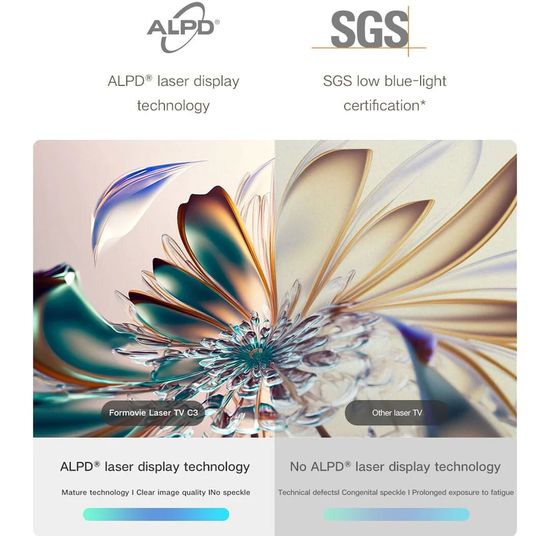
Conclusion
Overall, Xiaomi Formovie has successfully expanded the range of its 4K laser UST projectors. Today it covers the range from ‘budget’ segment of $ 1,500 to premium models costing up to $ 3,000. To be fair, the price difference of up to $ 1,000 ($ 2,600 Formovie Theater vs $ 1,600 – $ 1,800 for C2/C3) is quite adequate for the difference in their specs, but it seems too big. Probably, a model priced at $ 2,000 – $ 2,300 with mid-range specs will be able to harmoniously complete the UST line of Formovie projectors.
Of course, the lineups of JVC, Sony, and other industry leaders include powerful, high-contrast and bright projectors that start at $ 5,000 and can go up to $ 25,000. But such mid-focal models usually use a ceiling mount and are intended to be placed in the specialized rooms for viewing video content in high quality. The high popularity of UST projectors is due to their positioning as an alternative to traditional TV in an ordinary living room. At a similar price, they offer a huge picture of slightly lower quality, which is due to the higher brightness and contrast of TVs. However, in the dark it’s significantly reduced.
But TV manufacturers are also not wasting time adequately responding to consumer demand. In the last few years, the segment of huge TVs has been growing rapidly. For example, this year their range has expanded with 98″ TCL 98S550G, 98X955 (98QM850G) and Samsung 98Q80C models, whose prices range from $ 3,700 to $ 6,500.
This video shows Formovie Laser TV Cinema 2 or Formovie C2.
